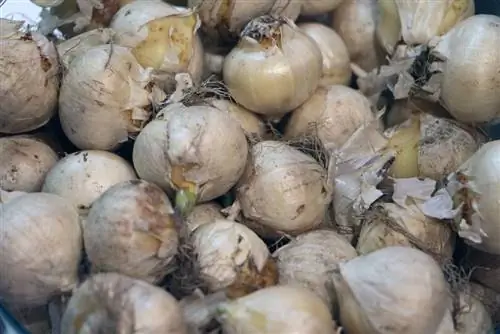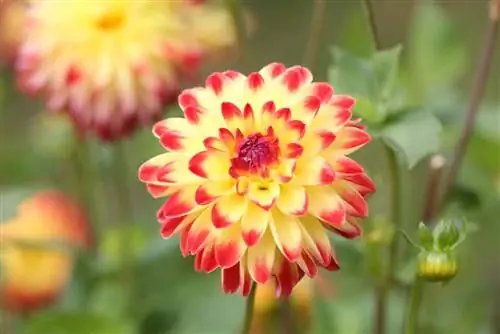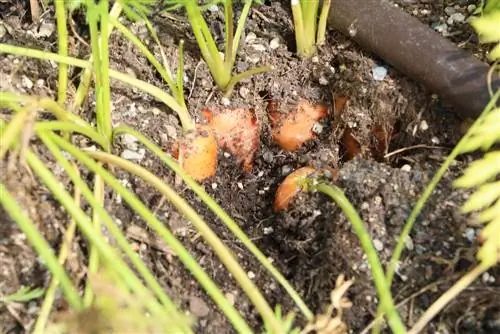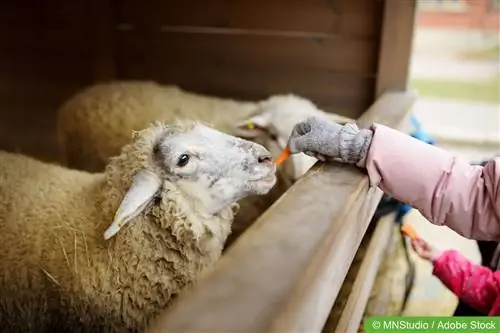- Author admin [email protected].
- Public 2023-12-17 03:39.
- Last modified 2025-01-24 12:45.
The carrot, which is a root vegetable, is now available in different shapes and colors, with the long, pointed, orange root being the best known in this country. It is usually cultivated as an annual. A two-year cultivation period is exclusively for seed collection. If you grow them in your home garden, at some point the question of storage arises. But what should you consider when storing?
Not every carrot is suitable for storage
If you want to grow carrots and store them after harvest, you should keep in mind that not every variety is suitable for this. Early and mid-early varieties are best consumed fresh or stored in the refrigerator for a few days. If you want to have some of your vegetables for longer, you should choose late-ripening varieties, as they are the ideal storage carrots. When it comes to storage, the correct harvest time plays a crucial role.
It's best to leave the carrots in the ground for as long as possible, because in the last few weeks of autumn they will increase in size again. The content of beta-carotene, aromatics and minerals also increases. However, they should be harvested before the first night frosts and, if possible, stored immediately.
Tip:
The particularly tasty variety 'Bolero' and the strong-growing 'Rodelika' are well suited for cellaring.
Preparing the vegetables for storage
So that there are no problems during storage, the carrots must be prepared accordingly. It is best to harvest on a dry day, as moist vegetables spoil more quickly. For this very reason they should not be washed. After you have taken them out of the ground, roughly knock off the adhering soil. Or you can use a vegetable brush. However, remaining soil can help prevent the vegetables from drying out.
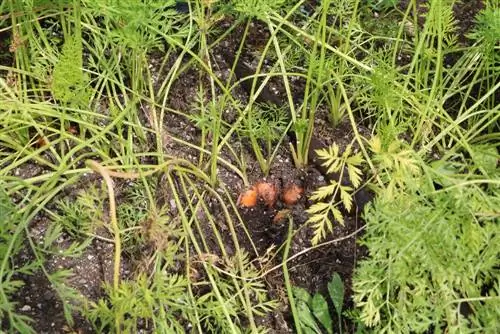
After rough cleaning, cut off the herb. This also applies to purchased bunch carrots. If you leave it at the root, it will deprive it of moisture. The carrot becomes dry, shriveled and soft. The next step is to sort out sick and damaged specimens, because even the smallest injuries can represent an entry point for fungi and bacteria. Now you can store.
Methods for storage
There are different ways to store root vegetables, depending on the storage quantity and local conditions. No matter which method you choose, you should never store it with ripe apples, pears or tomatoes. They all release the ripening gas ethylene, which can cause the carrots to take on a bitter taste and become inedible.
In the basement
Basements used to be perfect for storing vegetables thanks to their cool temperatures and humid climate. Today this is usually only the case in the basements of old houses. In modern basements, heating systems and insulation usually ensure that it is far too warm and dry.
- Carrots should generally be stored cool and moist
- Dark, cool cellar, optimal winter storage for root vegetables
- Temperatures between two and eight degrees are optimal
- High humidity between 70 and 80 percent
- It protects root vegetables from drying out
- Carrots lose water during storage
- They should be dry, in contrast to the surrounding air
- Store in the cellar soon after the harvest in the fall
- To do this, layer the vegetables in wooden boxes
- One layer of sand and one layer of roots
- Carrots should not touch each other during storage
- Top and bottom layers are made of sand
- Vegetables like this, keeps for several weeks
Tip:
Roots that have already been stored for a while should become crispy again if you put them in cold water for a while.
In wet sand
If the cellar is not suitable for storage, you can switch to another dark, cool and frost-free room, for example a shed or a darkened garden shed. In addition to sand, you need a bucket or a slightly taller wooden box and of course the carrots.
- First put a layer of sand in the bucket
- Sand should never be completely dry
- Then place the carrots upright as they have grown
- Fill with sand until completely covered
- Shake the bucket several times while filling it
- Necessary to fill any gaps or voids
- Then place the whole thing in a suitable place
- Remove vegetables in portions over the next few months
The sand should only be slightly moist and definitely not wet, otherwise the vegetables can become mushy and rot during storage. If necessary, you can also mix it with a little soil.
In a ground rental

If there is neither a cellar nor another storage room available, overwintering in a so-called ground rent is a good idea. This can be created in different ways. First, dig a correspondingly large pit in the garden. The side walls and bottom of the pit are lined with a close-meshed wire mesh to protect against voles. In the next step, sand and carrots are alternately layered on top of each other. At the very end, to protect against frost, there is a layer of earth and a layer of straw or leaves on top.
Tip:
If you have an old washing machine drum, you can also use it for storage by placing it in the ground. Sand is filled around the drum, the inside of the drum is piled up with sand and carrots and finally covered with insulating materials.
In the bed
In particularly mild regions with predominantly dry soils, late-ripening varieties can also be stored directly in the bed.overwinter. Ideally it is a raised bed, where the vegetables are better protected from hungry rodents such as voles. To protect the carrots from frost, you first turn off the cabbage and then pile it up a few centimeters high with soil. The whole thing is then covered with a fleece. As an alternative to piling up, you can also cover the root vegetables with a layer of dry leaves, hay or straw at least 10 cm thick.
Short-term storage in the refrigerator
For smaller quantities of both fresh and purchased bunch carrots, short-term storage in the refrigerator is recommended. Bunched carrots should be taken out of the foil immediately after purchase, because underneath they sweat relatively quickly, which accelerates spoilage. Even if stored in the refrigerator, the herb must be removed. Then wrap the carrots in moistened kitchen towels and place them in the vegetable compartment of the refrigerator.
Carrots should also stay fresh if you put them in a plastic container with water, seal it airtight and then put it in the fridge. There should be enough water to completely cover the carrots. The water must be changed at least every five days. Packaged appropriately and kept at consistently cool temperatures, carrots can stay fresh in the refrigerator for up to two weeks.



